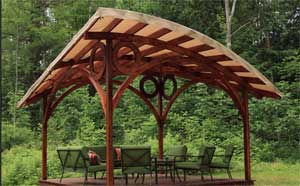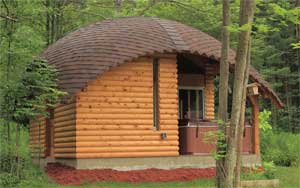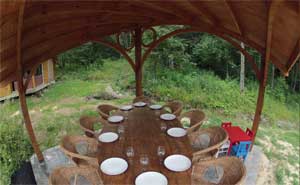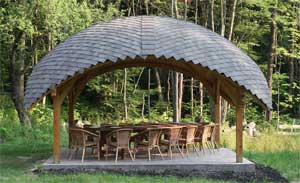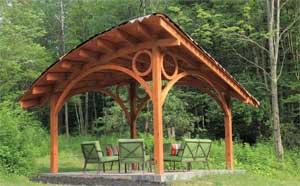
Tamas Fodor made his choice to be a professional woodworker early in life. He’s still at it, with a preferred focus these days on outdoor structures.
Tamas was born in Hungary and, due to the way the Hungarian educational system was set up, needed to “think about what you want to do in life” when he was about age 12. “I was a kid, so I really liked sweet stuff. I was thinking about going into a bakery, to make cupcakes and stuff or, since I was sailing competitively at that time, being a shipbuilder.
“I asked one of my mom’s friends for advice, and she told me, ‘Imagine your master work being eaten after you’ve finished it. But if it’s furniture, it will still be there in the future.”
Following this advice, Tamas entered a Budapest high school with a woodworking specialization, where he spent about five years learning about wood and about how to use machinery and hand tools. He was required to design and build a piece of furniture to get a degree.
He then pursued further studies in wood engineering and wood architecture – he has a master’s degree in the subjects – at the Academy of Mining and Forestry, which was originally established as a Forestry Institute in Slovakia in 1807 and moved to Sopron, Hungary, in 1919.
Due to its historic relationship with mining in the area, the school had a long history of realizing the importance of wood and forests. As the mining industry grew in Europe in the 1700 and 1800s, Tamas noted, “They had to think about how to support the tunnels underground. So they cut out all the forest all around the mines and used it to support the tunnels.”
Associates of the Academy of Mining and Forestry, Tamas said, “realized pretty early on that Europe was running out of trees.”
That’s one reason that Tamas ended up in the U.S. Wood here, he said, is cheaper, with more resources available, including the Canadian forests. “Europe mostly gets its wood from Russia,” he noted.
Also, “The architecture in the U.S. really amazed me,” he said. Although he noted Americans’ tendency to be awed by European architecture, Tamas said, “I saw and experienced European architecture. I wasn’t happy with it. I experienced building buildings in Hungary out of concrete and brick. Concrete roofing was sometimes easier and cheaper to get than lumber.
“American architecture – not in New York City, but in the suburbs – is basic wood 2×6’s. It’s just simple.”
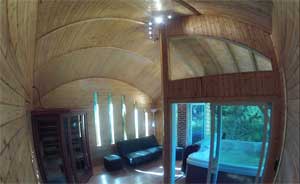
When he built a two-floor barn a couple of years ago, Tamas said, he was able to build 80 to 90 percent of it alone, with 2x4s and 2x6s. And, while, “People are saying it’s not going to last for 150 years, well, I’m not going to live for 150 years.”
For Tamas, “What is important to me is to go with nature and use what we can use. Is it harming nature if it’s wood? I’m absolutely sure it’s not, compared to steel or plastic.”
Those other resources, along with brick and concrete, Tamas noted, require energy to be expended in the form of burning during the manufacturing process, as well as transportation. “When you go to the bathroom and see ‘Save nature and dry your hands with this electric dryer,’ that doesn’t make sense to me; the electricity has to come from somewhere.”
Maintaining wood as a renewable resource, Tamas said, just requires “planning it forward. Imagine a forest like a pizza sliced into 10 slices. If you use one slice a year, cut out one slice and replant it, you can go around like a circle instead of using all the ‘slices’ at once and then waiting 10 years.”
Tamas’s specialty in wood is outdoor and garden furniture. “I really like spending time in the garden, being outside.” Stylistically, “I like to play with arches, with straight lines.”
Although currently he’s supporting his outdoor and garden furniture work with other work in New York City, it’s the outdoor line, branded as Garden Arc, that he’d like to expand. He’s done a couple of pieces like a boathouse or a poolhouse for clients, and he also has two main designs, “The Arches” and a “Butterfly “ pergola.
“Those are the two things I’m playing with at the moment. I have more ideas, but I have to start, and see how people are going to react.” The Arches, Tamas said, is a super-simple design, about 16’ x 16’, with one thick main beam that creates an arch. “What I really like is when you go inside, you have a very protected feeling,” Tamas said.
As for the Butterfly pergola, he described that as a more simple design, with an arch, a small column, a big column on a slight radius, and straight beams that go through. “It’s an artistic look even though it’s simple 2×8’s and 2×6’s.”
The base of his structures is made from pressure-treated wood, while the arches themselves, which are created from glued-up laminates, are Douglas fir or white fir. Due to the constant exposure to rain, sun, snow, etc., they need to be resealed every two or three years.
He also has visions of gazebos and more, but for now, ‘This is my starting work; I’m hoping to have more in the future,” Tamas said. “I just really like spending time in the garden, being outside.”
